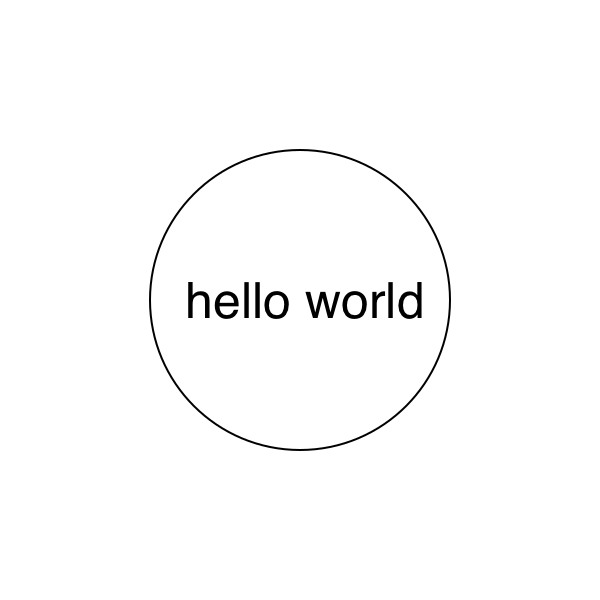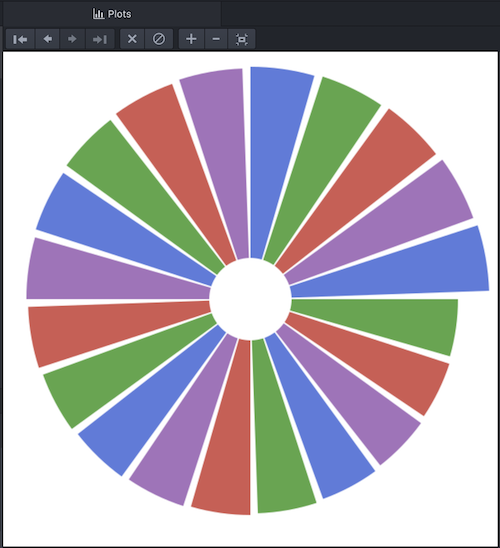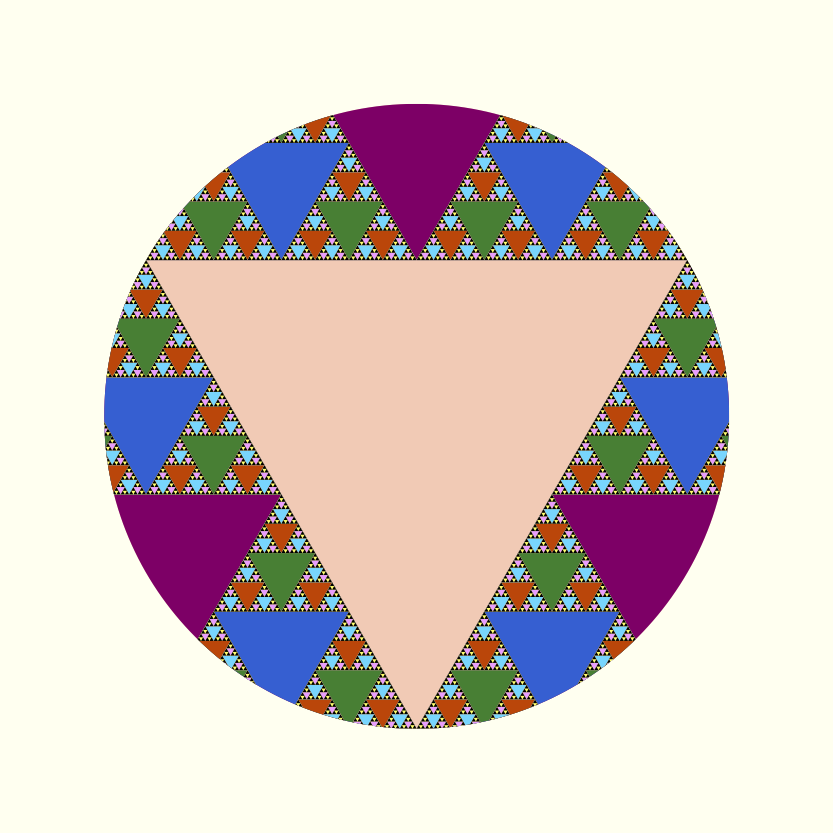Simple examples
The obligatory "Hello World"
Here's the "Hello world":

using Luxor
Drawing(1000, 1000, "hello-world.png")
origin()
background("black")
sethue("red")
fontsize(50)
text("hello world")
finish()
preview()Drawing(1000, 1000, "hello-world.png") defines the width, height, location, and format of the finished image. origin moves the 0/0 point to the centre of the drawing surface (by default it's at the top left corner). Thanks to Colors.jl we can specify colors by name as well as by numeric value: background("black") defines the color of the background of the drawing. text("helloworld") draws the text. It's placed at the current 0/0 point and left-justified if you don't specify otherwise. finish completes the drawing and saves the PNG image in the file. preview tries to display the saved file, perhaps using another application (eg Preview on macOS).
The macros @png, @svg, @pdf, @draw, and @imagematrix provide shortcuts for making and previewing graphics without you having to provide the usual set-up and finish instructions:
So this macro:
using Luxor
@png begin
fontsize(50)
circle(Point(0, 0), 150, action = :stroke)
text("hello world", halign=:center, valign=:middle)
end
expands the 140 or so characters into this 250+ character source:
Drawing(600, 600, "luxor-drawing-072453_822.png")
origin()
background("white")
sethue("black")
fontsize(50)
circle(Point(0, 0), 150, action=:stroke)
text("hello world", halign=:center, valign=:middle)
finish()
preview()The @drawsvg macro returns SVG code of the drawing which, in this Documenter-generated document, will be inserted into the HTML source of the page.
using Luxor
@drawsvg begin
background("black")
sethue("red")
randpoint = Point(rand(-300:300), rand(-300:300))
circle(randpoint, 5, action = :fill)
sethue("white")
foreach(f -> arrow(f, between(f, randpoint, .1), arrowheadlength=6),
first.(collect(Table(fill(30, 20), fill(30, 20)))))
endThe @draw and drawsvg macros create a PNG or SVG format drawing in memory, rather than saved in a file, and the result of executing the code is returned and, in many editing environments, included and displayed as a graphic. For VS Code, the graphic is usually displayed in the plot pane. In Pluto, it appears above the cell.
using Luxor
@draw begin
setopacity(0.85)
steps = 20
gap = 2
for (n, θ) in enumerate(range(0, step=2π/steps, length=steps))
sethue([Luxor.julia_green,
Luxor.julia_red,
Luxor.julia_purple,
Luxor.julia_blue][mod1(n, 4)])
sector(Point(0, 0), 50, 250 + 2n, θ, θ + 2π/steps - deg2rad(gap), action = :fill)
end
end

The Julia logos
Luxor contains built-in functions that draw the Julia logo, either in color or a single color, and the three Julia circles.
using Luxor
Drawing(600, 400, "../assets/figures/julia-logos.png")
origin()
background("white")
for θ in range(0, step=π/8, length=16)
gsave()
scale(0.2)
rotate(θ)
translate(350, 0)
julialogo(action=:fill, bodycolor=randomhue())
grestore()
end
gsave()
scale(0.3)
juliacircles()
grestore()
translate(150, -150)
scale(0.3)
julialogo()
finish()
# preview()
The gsave function saves the current drawing environment temporarily, and any subsequent changes such as the scale and rotate operations are discarded when you call the next grestore function.
Use the extension to specify the format: for example, change julia-logos.png to julia-logos.svg or julia-logos.pdf or julia-logos.eps to produce SVG, PDF, or EPS format output.
Something a bit more complicated: a Sierpinski triangle
Here's a version of the Sierpinski recursive triangle, clipped to a circle.

using Luxor, Colors
Drawing()
background("white")
origin()
function triangle(points, degree)
sethue(cols[degree])
poly(points, action = :fill)
end
function sierpinski(points, degree)
triangle(points, degree)
if degree > 1
p1, p2, p3 = points
sierpinski([p1, midpoint(p1, p2),
midpoint(p1, p3)], degree-1)
sierpinski([p2, midpoint(p1, p2),
midpoint(p2, p3)], degree-1)
sierpinski([p3, midpoint(p3, p2),
midpoint(p1, p3)], degree-1)
end
end
function draw(n)
circle(Point(0, 0), 75, :clip)
points = ngon(Point(0, 0), 150, 3, -π/2, vertices=true)
sierpinski(points, n)
end
depth = 8 # 12 is ok, 20 is right out (on my computer, at least)
cols = distinguishable_colors(depth) # from Colors.jl
draw(depth)
finish()
preview()The Point type is an immutable composite type containing x and y fields that specify a 2D point.
Simple numberlines
tickline() is useful for generating spaced points along a line:
using Luxor
@drawsvg begin
background("black")
fontsize(12)
sethue("white")
tickline(Point(-350, 0), Point(350, 0),
finishnumber=100,
log=true,
major=7)
end 800 150The arrow functions let you add decoration to the arrow shafts, so it's possible to use this function to create more complicated spacings. Here's how a curved number line could be made:
using Luxor
@drawsvg begin
background("antiquewhite")
_counter() = (a = -1; () -> a += 1)
counter = _counter() # closure
fontsize(15)
arrow(O + (0, 100), 200, π, 2π,
arrowheadlength=0,
decoration=range(0, 1, length=61),
decorate = () -> begin
d = counter()
if d % 5 == 0
text(string(d), O + (0, -20), halign=:center)
setline(3)
end
line(O - (0, 5), O + (0, 5), action = :stroke)
end
)
end 800 300The decorate function here adds graphics and text at the origin, which is located at each point along the shaft.
Draw a matrix
To draw the contents of a matrix, you can use a Table to generate the positions for the numbers.
It's sometimes useful to be able to highlight particular cells. Here, numbers that have already been used once are drawn in orange.
using Luxor
function drawmatrix(A::Matrix;
cellsize = (10, 10))
table = Table(size(A)..., cellsize...)
used = Set()
for i in CartesianIndices(A)
r, c = Tuple(i)
if A[r, c] ∈ used
sethue("orange")
else
sethue("purple")
push!(used, A[r, c])
end
text(string(A[r, c]), table[r, c],
halign=:center,
valign=:middle)
sethue("white")
box(table, r, c, action = :stroke)
end
end
A = rand(1:99, 5, 8)
@drawsvg begin
background("black")
fontsize(30)
setline(0.5)
sethue("white")
drawmatrix(A, cellsize = 10 .* size(A))
endSimple $\LaTeX$ equations
You can draw simple $\LaTeX$ equations by passing a string to text(), using the formats provided by the LaTeXStrings.jl package.
# drawing with 800×300 canvas
using Luxor
using MathTeXEngine
d = Drawing(800, 300, :svg)
origin()
background("khaki")
f(t) = Point(4cos(t) + 2cos(5t), 4sin(t) + 2sin(5t))
setline(15)
fontsize(35)
@layer begin
setopacity(0.4)
sethue("purple")
poly(20f.(range(0, 2π, length=160)), action = :stroke)
end
sethue("grey5")
text(L"f(t) = [4\cos(t) + 2\cos(5t), 4\sin(t) + 2\sin(5t)]", halign=:center)
finish()
dSee the Writing LaTeX section for more information. You'll have to install the fonts that MathTeXEngine.jl requires.
Drawing pixels
You can use Luxor to draw into an array of ARGB32 values, which are essentially colored pixels. This example uses Images.jl to display the array.
using Luxor, Colors, Images
# a matrix of 150 rows, 600 columns
buffer = zeros(ARGB32, 150, 600)
Drawing(buffer)
origin()
for i in 1:15:150
buffer[i:i+10, 1:600] .= RGB(rand(), rand(), rand())
end
for i in 1:100
randomhue()
ngon(rand(BoundingBox()), 15, 4, 0, :fill)
end
finish()
buffer
Triangulations
This example shows how a Delaunay triangulation of a set of random points can be used to derive a set of Voronoi cells.
# Inspired by @TheCedarPrince!
using Luxor, Colors, Random
Random.seed!(42)
d = @drawsvg begin
background("black")
setlinejoin("bevel")
verts = randompointarray(BoundingBox(), 40)
triangles = polytriangulate(verts) # create Delaunay
@layer begin
for tri in triangles
sethue(HSB(rand(120:320), 0.7, 0.7))
poly(tri, action = :stroke, close=true)
end
end
dict = Dict{Point, Vector{Int}}()
for (n, t) in enumerate(triangles)
for pt in t
if haskey(dict, pt)
push!(dict[pt], n)
else
dict[pt] = [n]
end
end
end
setopacity(0.9)
setline(3)
for v in verts
hull = Point[]
tris = dict[v]
# vertex v belongs to all triangles tris
for tri in tris
push!(hull, trianglecenter(triangles[tri]...))
end
sethue(HSB(rand(120:320), 0.7, 0.7))
if length(hull) >= 3
ph = polyhull(hull)
poly(ph, action = :fillpreserve, close=true)
sethue("black")
strokepath()
end
end
end 800 500
d